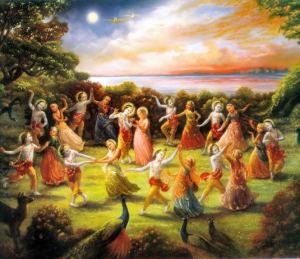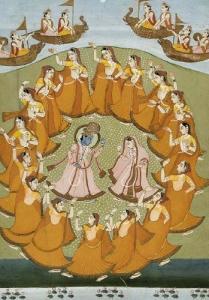
How and When to Practice Rāgānugā-Bhakti
HOW TO PRACTICE RĀGĀNUGĀ-BHAKTI
1. kṛṣṇaṁ smaran* janaṁ cāsya… tat-tat-kathā… [BRS 1.2.294]*
“Remember Krishna with a particular Vṛndāvana devotee who exemplifies the type of love you seek.”
how?
“By always doing kīrtan of their līlā, guṇa, rūpa, nāma.”
What is the remembrance for? To provide internal relevance to external practices…
2. seva-sādhaka-rūpeṇa siddha-rūpeṇa cātra hi… [295]
“Execute your seva so the external actions have internal significance to the vraja-bhāva you seek.”
What external actions?…
3. śravanot-kīrtanādīni vaidha-bhakty uditāni tu… [296]
“The actions described in relation to Vaidhi-bhakti, headed by śravaṇa and kīrtana.”
These three verses are Śrī Rūpa’s complete disclosure on how to practice rāgānugā-sādhana. He describes no further practices. No ekādaśa-bhava. No siddha-praṇālī. No smaraṇa-paddhati techniques. No* aṣṭha-kāla-līlā-smaraṇa*.
The implication is simple and clear: the other, more elaborate systems of rāgānugā-sādhana developed by subsequent ācāryas may indeed be supra-wonderful, but they are not absolutely essential. They are elaborations upon the principle of how to do Item #1, mostly.
WHEN TO PRACTICE RĀGĀNUGĀ-BHAKTI
Śrī Rūpa identifies a common starting point for all forms of uttama-bhakti (pure devotion). He says, “adau śraddhā” — “It starts from conviction/faith.” [BRS 1.4.15–16].
He doesn’t stipulate any exceptions, like, “adau śraddhā rāgānugas tv adau niṣṭhā.” (“It starts from conviction/faith, but Rāgānuga starts from niṣṭhā.”)
So rāgānuga has its own type of śraddhā (convictions), which comes from its own special type of kṛpā (mercy) and which results in its own special type of sādhu-saṅga (good association), from which we get advice and direction about its own special type of bhajan-kriyā (devotional practices), etc.
Then why is it very commonly taught (at least among ISKCON and Gauḍiya Maṭha circles) that rāgānugā begins from niṣṭhā? If we examine how Śrī Rūpa describes rāgānugā-śraddhā we will see that he does include a concept relevant to niṣṭhā.
rāgātmikāika-niṣṭhā ye vraja-vāsī-janādayaḥ |
teṣāṁ bhāvāptaye lubdho bhaved atrādhikāravān.
“The qualified person has an eager greed to obtain the bhāva (loving mood) of Vraja-vāsī, specifically fixed upon a particular Vraja-vāsī.” [BRS 1.2.291]
The qualification for practicing rāgānugā is “eager greed.”
Eager greed for what? Eager greed to obtain a certain state of being (teṣāṁ bhāvāptaye).
What state of being? The state of prema especially held by those who are residents of Vṛndāvana (vraja-vāsī-janādayaḥ).
Just any resident of Vṛndāvana? No, the eager greed is “fixed upon a specific exemplar of Rāga” (rāgātmikā-eka-niṣṭhā).
You can see the use of the word “fixed” (niṣṭhā). However this does not imply that rāgānugā begins as niṣṭhā for this would contradict BRS 1.4.15–16 explained above. In this sentence about the qualification for rāgānugā, the word “fixed” is not the main focus. The main focus in the sentence is on the word lobha (“eager greed”).
It’s good to note that “eager greed” (lobha) is a type of conviction (śraddhā), which is uniquely strong and specific.
In the next verse Śrī Rūpa explains how to measure this “eager greed.”
tat-tad-bhāvādi-mādhurye śrute dhīr yad apekṣate |
nātra śāstraṁ na yuktiṁ ca tal-lobhotpatti-lakṣaṇaṁ
“When ones mind hankers to hear about the sweetness of that loving mood, without any prodding or forethought, this is the sign that you are awakening eager greed.” [BRS 1.2.292]
Śrī Rūpa does not indicate that the arousal of this lobha has any pre-requisite (such as the attainment of niṣṭhā in vaidhi-bhakti), although in the next verse he does say, “Until this eager greed arises, you are qualified to practice vaidhi-sādhana.” [293]
In conclusion, lobha (the type of śraddhā which enables rāgānugā-sādhana) can appear at any point. The only prerequisite Śrī Rūpa identifies is:
kṛṣṇa-tad-bhakta-kāruṇya-mātra-lābhaika-hetukā
“The cause of gaining the ability to practice [and perfect] Rāgānugā is simply the kindness of a specific devotee of Krishna.” [BRS 1.2.309]
All of the above counteracts the idea that one has to first become purified by anartha-nivṛtti before one can obtain clear and specific lobha.
THEN, WHAT ABOUT NIṢṬHĀ???
So why is it sometimes said that the true qualification for rāgānugā bhakti doesn’t come until niṣṭhā, after anartha-nivṛtti?
I think this is a practical statement, and a very good one at that. Everyone is eager to rush into something that will include them in the “cool” club (or the “advanced” club), so, when dealing with new converts, it is very wise and prudent to say something like Prabhupāda sometimes said, something like, “first get rid of your anarthas, then your eager greed to follow a specific resident of Vṛndāvana will become clear.”
I also think there is practical validity to the observation that rāgānugā-sādhana and vaidhi-sādhana may not differ all that much in application until one starts to attain some medium level of advancement (like niṣṭhā) on either path.
However, to be faithful to Śrī Rūpa I believe we have to accept that anyone can begin rāgānugā-sādhana at any stage — immediate beginner, or otherwise. Practicing rāgānugā-sādhana is not a sign of “advancement,” this is a misconception that has bewildered devotees for long enough. Devotees practicing rāgānugā-sādhana still have mountains of advancement to make before they can hope to realize the goal: bhāva-bhakti. One has to begin as a fledgeling rāgānugā-sādhaka and diligently make progress by hearing about the objects of one’s spiritual attraction, and trying to apply the essence of what one learns to the practical viddhis one performs.
If it is a “sign” of anything, practicing rāgānugā-sādhana is simply a sign of extremely auspicious good fortune.
There is an awfully suffocating idea that rāgānugā-sādhana is anathema to Śrīla Prabhupāda’s line. The idea that Śrīla Prabhupāda created a society for vaidhi-bhakti is a sad mistake, held by many of his critics but even more unfortunately held by many of his disciples and followers as well. If given any chance, I would boldly and perhaps “proudly” declare that Śrīla Prabhupāda, as the empowered representative of Śrī Caitanya, created a society for rāgānugā-sādhana without being gaudy and overt about it. He created an implementation of rāgānugā-sādhana that is very realistic and practical for the audience ISKCON mainly serves: the modern globalized world (Though I think we, his followers, have done lousy at realizing and implementing his vision on this). All the viddhis adopted by Śrīla Prabhupāda for ISKCON are done so under BRS 1.2.293 & 296, cited above.







































 HG Praharna Devi Dasi(GVT)
HG Praharna Devi Dasi(GVT)

 Odissi Dance Classes
Odissi Dance Classes Sunday School
Sunday School